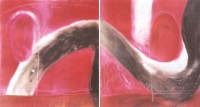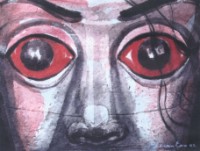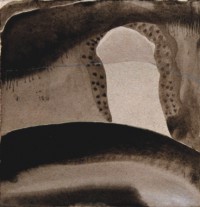|
In
Retrospect
Dying
Young
Remebering
Sanatan Biswas, a budding young artist whose life was cut
short by a stroke
Mustafa
Zaman
Dying
young was the only way Sanatan Biswas could attract the attention
of the art establishment, where he was an outsider trying
to trudge through the academic routines year after year. After
witnessing the series of experimental works that the budding
talent left behind, one of the teachers commented, "I
didn't know he was this good." The comment came at a
time when Sanatan has gone past the barrier of this mortal
world and has become immune to any judgement thrown at him
or his art work.
 Obscured
by his unconventional living and his absence from the centre-stage
at the Institute of Fine Arts, Dhaka, Sanatan remained a name
known only among his own circle that consisted of a handful
of students, fringe artists, poets, journalists and strings
of well-wishers. Obscured
by his unconventional living and his absence from the centre-stage
at the Institute of Fine Arts, Dhaka, Sanatan remained a name
known only among his own circle that consisted of a handful
of students, fringe artists, poets, journalists and strings
of well-wishers.
Often
he could be spotted sitting in the tea-stalls in front of
the Institute or having a conversation with his companions
with his back against the boundary wall of the art institution,
from where he acquired his Masters in the Department of Oriental
Art. His ruffled hair, childish restlessness of the eyes that
manifested a constant thirst for understanding the realities
around him were all smothered in his marked amity and reticence.
 An
artist who learned his first lessons from his mother, who
taught her school-going child how to draw birds and animals
at an early age, Sanatan always knew that he was destined
to vie with the norms of art that is not rooted deep into
the collective consciousness. Though, in the MFA (Masters
of Fine Arts) dissertation he wrote, "There is no alternative
to the education that one receives at the Institute of Fine
Arts, as most of the famed artists came out of this academy",
his views on art often questioned the conventional ethos.
The ideas and tenets that govern Dhaka's mainstream were never
his concern. An
artist who learned his first lessons from his mother, who
taught her school-going child how to draw birds and animals
at an early age, Sanatan always knew that he was destined
to vie with the norms of art that is not rooted deep into
the collective consciousness. Though, in the MFA (Masters
of Fine Arts) dissertation he wrote, "There is no alternative
to the education that one receives at the Institute of Fine
Arts, as most of the famed artists came out of this academy",
his views on art often questioned the conventional ethos.
The ideas and tenets that govern Dhaka's mainstream were never
his concern.
Although
the bulk of his works, some lost and some found in a portfolio
that he built up over the last few years, testifies to his
tendency of melding the Western strand of abstraction with
the Oriental tendency.
Posterity
for Sanatan begins with a book and a show that, for the first
time, encapsulate the works produced by Sanatan. The show
that took off on July 25 at the Zainul Gallery, Institute
of Fine Arts, displays the experimental pieces he produced
in his Masters years. "He had been planning for a show,
and these are the 42 works that we chose from more than a
hundred he kept separately with a show in mind," says
Nasimul Kahabir, a friend and classmate.
 Sanatan
is lucky to have left a cluster of friends behind, who not
only mourn his death but also celebrate his art by publishing
an adequately illustrated book and by arranging his first
solo exhibition. After surveying the works, those who knew
him well would always want to crave for more. He was a prolific
artist. Yet it was a fact that only his close associates knew,
as he never flaunted his ability. Sanatan
is lucky to have left a cluster of friends behind, who not
only mourn his death but also celebrate his art by publishing
an adequately illustrated book and by arranging his first
solo exhibition. After surveying the works, those who knew
him well would always want to crave for more. He was a prolific
artist. Yet it was a fact that only his close associates knew,
as he never flaunted his ability.
He was
an artist freshly out of art school, contemplating the future
course. Unfortunately, at that crucial stage his life summarily
ended. It is impossible to find the whole of Sanatan in the
works of art, as art is more about art itself than about real
life. However, Sanatan himself believed that art must reflect
the lived experiences. It is a great loss on our part that
we could not see that full-blown mind taking charge of his
artistic actions.
Yet after
taking everything into account, one may recognise a different
beat in his creations. And the words of his friends that commemorate
his life, too, bring into focus a Sanatan with a different
curve of consciousness.
 Sanatan
was standing at the threshold of his career. His attempts
at working out a personalised solution to the problems of
artistic creation were at an initial stage. His resolve was
firm; he used to assert that art that is not deeply rooted
in the indigenous thoughts is meaningless. Sanatan himself
found little time to nurture his passion for the traditional.
But many who came in touch with him realised that by tradition
he was not referring to a body of knowledge that the academics
usually consider to be a constant source of Bangali pride.
His was a world that drew its nectar from the real and the
lived experiences. Perhaps this is why he could string all
his experiences -- from the teachings of his mother to that
of his teachers -- in one spectrum of thought. Sanatan
was standing at the threshold of his career. His attempts
at working out a personalised solution to the problems of
artistic creation were at an initial stage. His resolve was
firm; he used to assert that art that is not deeply rooted
in the indigenous thoughts is meaningless. Sanatan himself
found little time to nurture his passion for the traditional.
But many who came in touch with him realised that by tradition
he was not referring to a body of knowledge that the academics
usually consider to be a constant source of Bangali pride.
His was a world that drew its nectar from the real and the
lived experiences. Perhaps this is why he could string all
his experiences -- from the teachings of his mother to that
of his teachers -- in one spectrum of thought.
The day
his dead body was carried to the institute portico on December
24 last year, many were still busy raising funds for his treatment.
He spent ten days in a private hospital in Mohakhali, where
after a major operation to remove a clot of blood in the brain
on December 16, he showed signs of recovery before going into
a coma. During the time Sanatan was in a coma, the student
community came forward to help in an unprecedented way. While
Ongkar, a student body that coached the admission-seeking
students in the year 2003, contributed a hefty amount, his
friends stepped up their drive to raise fund. They involved
popular bands like Dalchhoot, Mondira, and singers like Mahmuduzzaman
Babu to organise a concert. Everyone thought that the money
would go to the operation that might bring Sanatan back. Many
organisations like Gallery Chitrak, Vertical, a group of ceramic
artists, Green Field animators and many others chipped in.
There was a concerted effort that helped raise a lot of money
within days. When his near ones and well-wishers were doing
their utmost and were hoping against hope, Sanatan made his
exit from this mortal world.
 In
the preface of the book, his friends wrote that it is impossible
to showcase the life and thoughts of Sanatan, the book only
makes an effort to cut a slice through the very essence of
what was Sanatan. Both the book and the show encapsulate his
memories, the one plausible way to remember one by. In
the preface of the book, his friends wrote that it is impossible
to showcase the life and thoughts of Sanatan, the book only
makes an effort to cut a slice through the very essence of
what was Sanatan. Both the book and the show encapsulate his
memories, the one plausible way to remember one by.
Born in
a family where members used to while away their time having
debates over Boishnab or Sufi thoughts, Sanatan grew up like
a man who takes life as it comes. Alongside his mother, who
sympathised with him in his pursuit of study, he had his pishi
(paternal aunt) by his side, acting like a mentor, helping
the family, providing financial support for his study from
time to time. After passing the SSC, it was time to decide
on a future course. But for Sanatan, life was not an easy
ride. During his study in Rampal Degree College in Bagerhat,
financial constraints spurred him to try out his luck as a
TV and radio mechanic. He was ambivalent about his future
at this stage. However, he soon managed to bounce back to
his desired track, which is to pursue his real passion.
In
1990, Sanatan sought admission in Khulna Art College and it
is here that he took the first step towards his desired goal,
which was to become an artist. He spent three years in rigorous
training, and participated in all the annual art exhibitions
of the college. It was after acquiring the Preliminary Degree
from Rajshahi University that he came to Dhaka for higher
education. He stood first in the admission test in the Department
of Oriental Art that made his entry into the Institute of
Fine Art an occasion to renew his resolve.
However,
his artistic pursuit did not make him stand at a certain remove
from all the other things in life, as is often the case with many artists.
In fact, he kept himself involved in a lot of issues that
he felt passionate about. The movements to stop the Dhaka
University authorities to take down the existing Shahnewaj
Bhaban, the hostel for the students of the Art Institute,
to replace it by a market-cum-hall, and to overthrow the former
VC after the attack on the students of Shamsunnahar Hall,
saw an enthusiastic Sanatan taking the issues to his heart.
other things in life, as is often the case with many artists.
In fact, he kept himself involved in a lot of issues that
he felt passionate about. The movements to stop the Dhaka
University authorities to take down the existing Shahnewaj
Bhaban, the hostel for the students of the Art Institute,
to replace it by a market-cum-hall, and to overthrow the former
VC after the attack on the students of Shamsunnahar Hall,
saw an enthusiastic Sanatan taking the issues to his heart.
He had
a history of getting involved in things of social importance.
Every time he got involved into a movement, it was to make
an effort to right the wrong. He even wrote a drama on the
exploitation and discrepancy that went on in the name acquiring
plots for shrimp farming in the Khulna-Bagerhat area. That
was back when he was in school. That conscientious objector
never died in him.
We mourn
his departure, but his deeds will always be there to inspire
us. It was after the result came out at the end of the year
2003 that he took a breather and retreated to his village
home. No one suspected that his sojourn would be the last
goodbye. "He stayed in the village for two long months,
which was unusual for him, as he was so engrossed in what
took place in Dhaka that he never stayed out of the city for
more than a week or so," says Tokon Thakur, a poet and
a soul-mate. But no one knew that at the age of 37 he would
only return to Dhaka to breathe his last after having suffered
a stroke.
Dipankar
Goutam, a journalist and a friend, wrote in the book, "We
look at our faces now and I see we are getting older. Sanatan
will forever be of the same age." And it is our loss
that we did not have the chance to grow older with him.
Copyright
(R) thedailystar.net 2004
| 